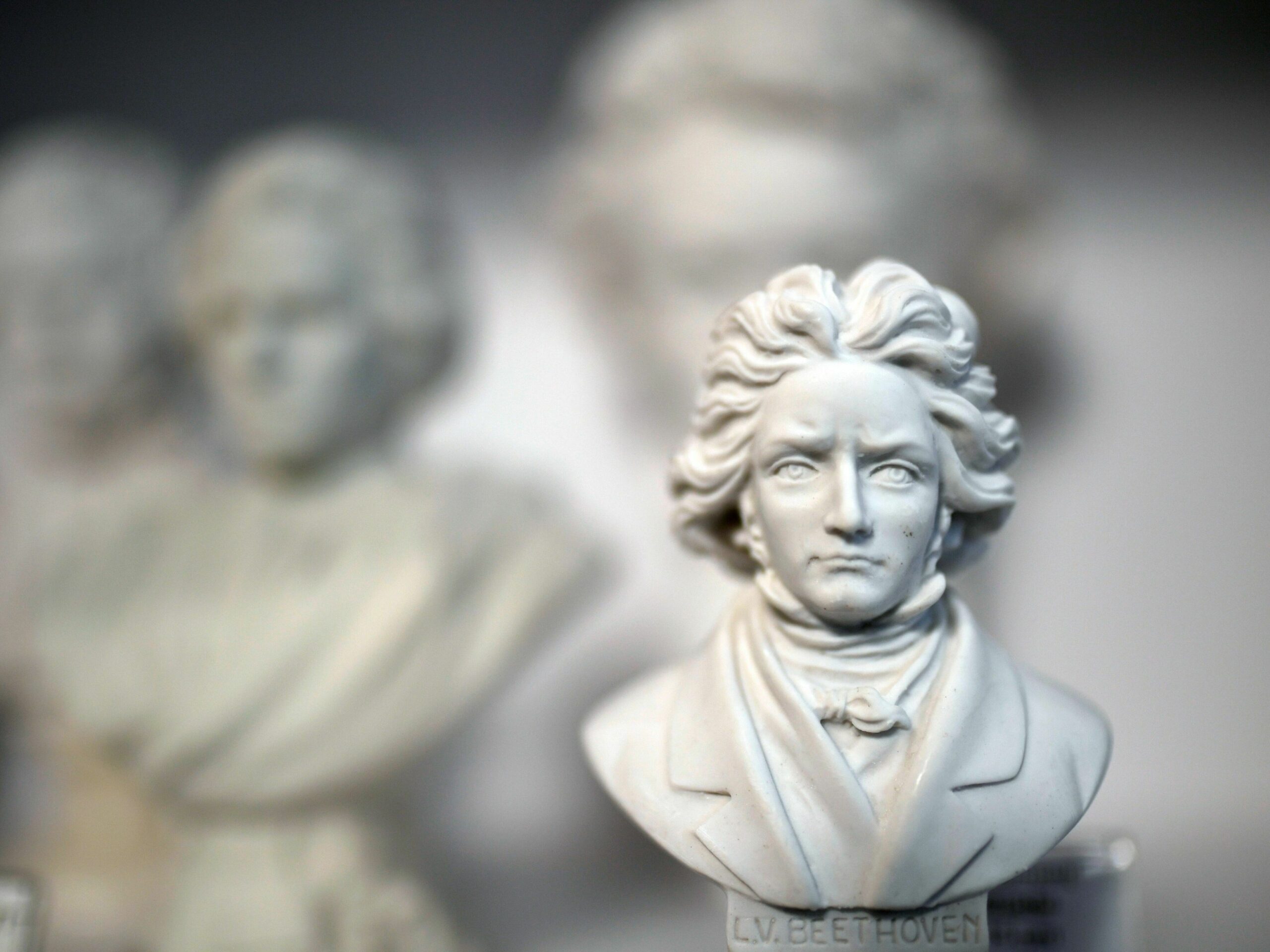
[audio mp3="https://ondemand.npr.org/anon.npr-mp3/npr/atc/2023/03/20230322_atc_scientists_sequence_beethovens_genome_for_clues_into_his_painful_past_.mp3?orgId=1&topicId=1007&d=281&p=2&story=1165308267&ft=nprml&f=1165308267"][/audio]
Ludwig van Beethoven lived a life of pain. His suffering was so great that in 1802 — while only in his early 30's — the classical composer and pianist penned a letter to his brothers describing how his maladies had soured his demeanor and isolated him from society.
In this message, known as the Heiligenstadt Testament, Beethoven asked that the physical ailments that plagued him in life be publicized after his death.
"As soon as I am dead if Dr. Schmid is still alive ask him in my name to describe my malady and attach this document to the history of my illness so that so far as possible at least the world may become reconciled with me after my death," he wrote in his native German.
Now, scientists have done one better: They've sequenced Beethoven's genome. The findings, published in the journal Current Biology, offer clues about the health challenges that shaped him as a person and the musician he came to be.
Beethoven famously suffered from progressive hearing loss, which made social interactions a source of increasing anxiety and ended his career as a performing musician by his mid-40s. He also struggled with chronic gastrointestinal problems and liver disease, which only compounded his misery.
In spite of these difficulties, Beethoven is still regarded as one of the greatest composers in Western music.
His work has ensnared countless listeners, including Tristan Begg, a biological anthropology PhD student at the University of Cambridge, and one of the researchers involved in the genetic sequencing project.
When he was a kid, Begg listened to all kinds of music.
"ACDC, Led Zeppelin, Mozart, Prokofiev," he recalls. "Loved old Ragtime Blues — Blind Blake, Mississippi John Hurt."
But then came Christmas Day of 2007, when Begg was 17 years old. One of his presents that holiday was a record player. He dropped the needle on Beethoven's Moonlight Sonata, and his world would never be the same.
"It really just hit me. It was the first 'dun dun dun,'" Begg says, referring to the melody that subtly but powerfully surfaces after half a minute. "I heard that... I had to catch myself, stop myself from crying. That sparked this obsession, both with the music and with the man."
That obsession inspired Begg several years later to pursue a Master's project in Germany. It involved a hunt for evidence that Beethoven's afflictions may have had a genetic foundation. The first was his hearing loss.
The second was his set of debilitating GI issues. These were frequent attacks of "violent diarrhea," says Begg. "They could last for days. They were also accompanied by bowel pains."
And finally, there was Beethoven's liver disease — complete with jaundice, bleeding in his esophagus, and bean-sized nodules in his liver identified in his autopsy. It's this liver disease "that seems to have been the primary cause of his death," says Begg.
To find out whether any of these health problems had a genetic cause, Begg first had to get his hands on Beethoven's DNA. He figured he'd find it in locks of hair likely dating back to the 1800s, and supposedly originating from the great composer's head.
But extracting genetic information from the ancient DNA associated with these rare strands was an immense challenge.
"Your genome starts out in these enormous stretches of DNA," says Begg, billions of nucleotides long. But "the average fragment length of the DNA we were getting from these hairs was about 15 nucleotides long" — super short pieces.
The DNA sequencing task confronting Begg, therefore, was like reconstructing a vast multi-volume encyclopedia from a couple hundred thousand sentence fragments.
"So you have to use some of the most advanced ancient DNA techniques in the world," Begg says.
But when he used those techniques, he found — to his great dismay — that the three locks of hair came from three different people. (One was indeed authentic but Begg didn't know that at the time.)
"Depressing is the word," he says of the realization. "I thought the project had failed at that point."
Begg moved on to pursue his PhD on a different topic altogether. But then one of the study's sponsors, a member of the American Beethoven Society, acquired a few new locks of hair. When tested, they all originated from the same person, and that individual was almost certainly Ludwig van Beethoven.
"Suddenly," Begg says, "the project had a pulse again."
The sequencing work could now begin in earnest. He focused on the best preserved sample to look for evidence of inherited disease.
First, there was the matter of his deafness, which, alas, didn't turn up anything conclusive. That's possibly because we don't know enough about the link between the risk and the genetics of otosclerosis — a condition typically characterized by abnormal bone growth in the middle ear and the leading explanation for what caused Beethoven's hearing loss.
Second, there were the GI issues. "We did find that he was modestly protected against irritable bowel syndrome," says Begg. In addition, Beethoven was most likely not lactose or gluten intolerant. So there was nothing definitive there either.
The real smoking gun came when Begg looked into possible causes of Beethoven's liver disease. One gene in particular, called PNPLA3, leapt out. "It would have roughly tripled his risk for developing the full spectrum of liver disease," says Begg.
On its own, the gene's not too concerning. But "it does become a problem if you're drinking substantial quantities of alcohol." And that's something that Beethoven likely did according to numerous accounts.
Plus, Begg found other DNA in Beethoven's hair shafts — from hepatitis B virus. "This is globally one of the major causes of cirrhosis and liver cancer," says Begg.
And all three factors — the gene, the drinking, and the hepatitis B — they would have all interacted. "Whichever way you cut it," he says, "it really comes as no surprise he died of cirrhosis, ultimately, at the age of 56."
George Church, a molecular technologist at the Harvard Medical School who wasn't involved in the study, says it's solid research. He just wished the DNA had yielded more answers.
"I think the disappointing thing was the lack of explanation for hearing loss," says Church. "It's not the fault of the authors. It's the fault of the specimens."
Perhaps in the future, the technology will improve to provide a better understanding of the source of Beethoven's deafness.
"There's all sorts of things that you can do tomorrow," Church says, "that you didn't do yesterday."
One finding was unexpected. When Begg compared Beethoven's Y chromosome to the five living members of the van Beethoven family today, "they are deeply divergent," he says. That means that sometime between 1572 and 1770, an "extra-pair paternity event" occurred in Beethoven's paternal line. In other words, says Church, "some premarital or extramarital sexual liaison" resulted in an individual with a different father sometime in Beethoven's recent ancestry.
For some, this study helps bring the composer to life. Luke Welch, a concert pianist based in Toronto, says it lays bare that the man's "physical struggle was real," something he feels when playing Beethoven's music, especially his symphonies and his late piano sonatas.
These sonatas, Welch says, "are a huge departure from his earlier piano sonatas, and you could tell he is completely in another frame of mind from anything his contemporaries were composing."
"The demands he puts on the performer are really extreme," explains Welch. "It sounds very natural to the listener. But to the performer, you really have to fight through certain passages to make it as coherent and cohesive as he wants."
In other words, he summarizes, "The beauty is the struggle."
As for Begg — who spent years wading through Beethoven's DNA — he says that now that his genetic opus has been published, it'll be Beethoven's Eroica (his third symphony) that he'll listen to first.
"It takes a while to appreciate it, but it is an astounding piece of music," he says. "He never wastes a note. He doesn't waste your time. Your feelings are in the best hands."
Perhaps Beethoven would have felt similarly — that his locks of hair and his DNA have been in good hands, too.
9(MDEyMDcxNjYwMDEzNzc2MTQzNDNiY2I3ZA004))
Transcript :
MARY LOUISE KELLY, HOST:
So there's this letter that Beethoven, the great classical composer, wrote to his brothers when he was in his early 30s. He rails against his deafness and asks that his various health problems be described after his death. Well, a new study does just that. Science reporter Ari Daniel has more.
ARI DANIEL, BYLINE: When he was a kid, Tristan Begg listened to all kinds of music.
TRISTAN BEGG: AC/DC, Led Zeppelin, Mozart, ragtime blues.
DANIEL: But then came Christmas 2007, when Begg was 17. One of his presents was a record player, and when he dropped the needle on this - Beethoven's "Moonlight Sonata" - his world would never be the same.
BEGG: It was the first dun, dun-dun (ph).
(SOUNDBITE OF LUDWIG VAN BEETHOVEN'S "PIANO SONATA NO. 14")
BEGG: I had to catch myself to stop myself from crying. That sparked this obsession, both with the music and with the man.
DANIEL: That obsession inspired Begg to later pursue a master's project in Germany, one involving a hunt for evidence that Beethoven's afflictions had a genetic basis; the first being his hearing loss, the second a set of debilitating gastrointestinal issues.
BEGG: These were attacks of often, he describes, violent diarrhea.
DANIEL: And finally, there was Beethoven's liver disease, involving jaundice and bean-sized nodules in his liver.
BEGG: That seems to have been the primary cause of his death.
DANIEL: Begg first had to get his hands on Beethoven's DNA, which he managed to do - ancient DNA from locks of hair likely from the 1800s and supposedly originating from the great composer's head.
BEGG: Your genome starts out in these enormous stretches of DNA. The average fragment length we were getting from these hairs was about 15 nucleotides long.
DANIEL: Which is super short. Begg had to sequence Beethoven's entire genome from those fragments.
BEGG: So you have to use some of the most advanced ancient DNA techniques in the world.
DANIEL: But the results were depressing.
BEGG: Those three locks of hair came from three different people. I thought the project had failed.
DANIEL: Begg moved on to the University of Cambridge to do a Ph.D. in biological anthropology on a different topic altogether. But then a few new locks of hair surfaced, all originating from the same person, who almost certainly was Ludwig van Beethoven.
BEGG: Suddenly, the project had a pulse again.
DANIEL: Begg focused on sequencing the best-preserved sample, which he then surveyed for evidence of disease. First, there was his deafness, which, alas, didn't turn up anything conclusive. Then there were the GI troubles.
BEGG: We did find that he was modestly protected against irritable bowel syndrome.
DANIEL: And that he was likely not lactose or gluten intolerant, so nothing definitive there either. But then, Begg looked into possible causes of liver disease. One gene in particular leapt out.
BEGG: It would have roughly tripled his risk for developing the full spectrum of liver disease.
DANIEL: The gene's not too concerning on its own, but...
BEGG: It does become a problem if you're drinking substantial quantities of alcohol.
DANIEL: Which Beethoven probably did. Plus, Begg found other DNA in his hair shafts from hepatitis B virus.
BEGG: This is globally one of the major causes of cirrhosis and liver cancer.
DANIEL: And all three factors - the gene, the drinking and the hepatitis B - they would have all interacted.
BEGG: It really comes as no surprise he died of cirrhosis at the age of 56.
DANIEL: Begg and his colleagues published their findings in the journal Current Biology. George Church, a molecular technologist at the Harvard Medical School who wasn't involved in the project, says it's solid research. He just wished the DNA had yielded more answers.
GEORGE CHURCH: Yeah, I think the disappointing thing was the lack of explanation for hearing loss. It's not the fault of the authors. It's the fault of the specimens.
DANIEL: For some, this study helps bring the composer to life. Toronto-based concert pianist Luke Welch says it lays bare that the man's physical struggle was real, something he feels when playing Beethoven's music.
LUKE WELCH: The demand he puts on the performer are really extreme. You really have to fight through certain passages to make it as cohesive as he wants.
DANIEL: And is there beauty in the struggle?
WELCH: The beauty is the struggle.
DANIEL: As for Tristan Begg, he says now that his genetic opus has published, it'll be Beethoven's "Third Symphony", "The Eroica", that he'll listen to first.
BEGG: Your feelings are in the best hands.
DANIEL: And I wonder whether Beethoven might have thought that his locks of hair, his DNA, have been in some pretty good hands too.
For NPR News, I'm Ari Daniel.
(SOUNDBITE OF LUDWIG VAN BEETHOVEN'S "SYMPHONY NO. 3") Transcript provided by NPR, Copyright NPR.









